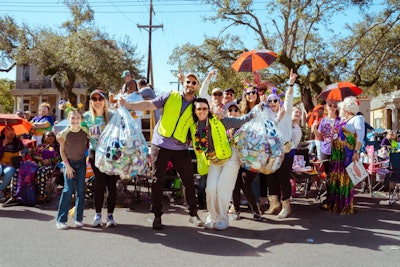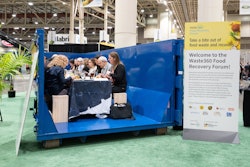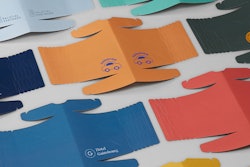
NEW ORLEANS—A couple of decades ago, Mardi Gras was measured by how many tons of garbage had been collected, remembers Walt Leger III, CEO of destination marketing organization New Orleans & Company. "That was a way of judging just how great of a party it had been."
In recent years, though, the city has been actively working to shift that mindset—and double down on the iconic event's sustainability efforts, like with its two-year-old Recycle Dat! initiative, a collaboration among 25 local groups that helped divert over 10 tons of waste from landfills during last month's celebration. These days, Leger says, "We're measuring success based on how much recycling we're able to do, and how much waste we're able to divert from the landfill."
BizBash recently sat down with Leger for an in-depth chat about all things Mardi Gras, including the sustainability efforts, the event's $900 million economic impact, the cultural significance to its residents, and what else goes into producing "the largest free party on earth."
 New Orleans & Company CEO Walt Leger IIIPhoto: Courtesy of New Orleans & Company
New Orleans & Company CEO Walt Leger IIIPhoto: Courtesy of New Orleans & Company
Can you talk a bit about the cultural significance of Mardi Gras to New Orleans and its residents?
It's such a central part of our culture. New Orleans is a very Catholic city, and culturally, it marks the beginning of the Lent season—so Mardi Gras is historically the time when you have your last big hurrah, and then you go into a season of sacrifice leading up to Easter. Beyond that, though, it’s a major ritual for the whole community. You’re seeing people of all ages, of all socioeconomic backgrounds, of all races, coming together in one place at one time to have this massive community celebration.
What it is to people who actively engage in the production of Mardi Gras is an annual time to celebrate what they've been doing almost all year—which is preparing for Mardi Gras! That’s the float designers, the artists, and the artisans who are creating the show, but it's also the individuals who are members of these crews that come together throughout the year to do community service projects, fundraising for charities, social events, and celebrations. Ultimately, this is the culmination of all of that work and effort, and a celebration of their individual organizations’ efforts throughout the year.
I think anyone who spends time in New Orleans knows that this is a really important event for the city, not just because it brings people to town and not just because it's well known around the world—but because it's really a big part of how we live our lives.
I was going to ask how early preparations begin each year, but it sounds like they never really stop.
They don't really! There may be a break right after where people catch their breath. But for the people who are really in it, it's a year-round thing. Everything starts in earnest three to four months before Mardi Gras, but there are a lot of things that are happening throughout the year.
The interesting thing about Mardi Gras is that there isn't really anyone who is in charge of it. It is 34 different organizations that throw their own parades. There’s a framework established via the city, but each group ultimately bears responsibility for producing this event.
How is New Orleans & Company involved in making Mardi Gras a logistical success?
We play a role in hosting and promoting some of the important underlying events. Lundi Gras, for example, is the day before Mardi Gras and kind of kicks off the celebration; we're hosts and partners in promoting and supporting that event. We have also worked with the city of New Orleans directly on a program called Recycle Dat!, which is looking at how we can decrease garbage going into landfills and increase recycling opportunities at Mardi Gras.
We're also big supporters of law enforcement. First responders are critical to Mardi Gras because they provide public safety support—but they also provide medical support and emergency response support. Whenever you bring a million people together along about a six- or seven-mile stretch, some issues come up—and so without them, it's impossible to even imagine being able to do this. We work with the Restaurant Association to provide food as well as lodging opportunities for law enforcement officials who come in from throughout the state. For the last couple of years, we’ve even utilized our building, which is along the parade route, as a place where all law enforcement and first responders can come to use restroom facilities, get food, and take a break.
Otherwise, we offer general support to our members who are engaging throughout Mardi Gras, whether it's restaurants and hotels or event planners, meeting planners, and DMCs. The whole city is really in Mardi Gras mode for 12 days.  In the second year of the Recycle Dat! program, the city collected over 10 tons of material, including 4,288 pounds of glass, 4,564 pounds of aluminum cans, 12,729 pounds of beads and throws, and 306 pounds of plastic bottles.Photo: Courtesy of New Orleans & Company
In the second year of the Recycle Dat! program, the city collected over 10 tons of material, including 4,288 pounds of glass, 4,564 pounds of aluminum cans, 12,729 pounds of beads and throws, and 306 pounds of plastic bottles.Photo: Courtesy of New Orleans & Company
You’ve touched a bit on the Recycle Dat! initiative. What inspired it, and how did it evolve in its second year?
We recognize that sustainability is an important factor in the way that people make decisions about where to travel. And members of our community were beginning to speak out a little more fervently about how to reduce the carbon footprint and impact of Mardi Gras, and we wanted to provide a leadership role. We worked with 25 different partners throughout the city, including a really great group called Grounds Krewe, a nonprofit that’s working toward developing local products that are more sustainable—things that can be thrown that aren’t just beads.
We also work closely with the Can Manufacturers Institute and a number of other nonprofits like Glass Half Full. Last year, when the initiative launched, it was largely volunteer-led and it was very successful. And this year, we were able to more than double the production of last year's event: over 2 tons of glass, over 150,000 aluminum cans, more than 12,700 pounds of beads and other throws, much of it collected at the Morial Convention Center, which is where a lot of the big Mardi Gras celebrations finish.
We hear from visitors and guests who are like, ‘Wow, this is a lot of garbage.’ We wanted to get out in front of this as much as possible, and I feel really good about where we are—but, obviously, we have a lot more work to do. There have been issues in the past with beads and other things clogging up drainage catch basins; working to avoid those things makes the community safer, and makes Mardi Gras something that can continue for generations to come.
As cities worldwide aim to host more sustainable events, what lessons do you think they can learn from Mardi Gras?
I think it's just about intentionality. When you have something as culturally significant and as historically important to a community, it’s easy to only see it through the eyes that you've always seen it through. As a resident and a local, and someone who was born and raised here in New Orleans and who has seen Mardi Gras up close and personal for 45 years, it's sometimes difficult to take a step back and say, 'That's not great.’ I'm proud of our community for taking a look in the mirror and saying, ‘We can do better.’
You see different organizations stepping up with more traditional glass beads that are going to last and not be plastic garbage. You see people throwing things like bamboo toothbrushes and sunglasses and other sustainable materials. Tossing things out to people keeps the tradition alive, but it’s about being more thoughtful and forward-thinking—which is a great symbol of what our city ultimately stands for, which is preservation of the past and celebration of history, but also progress and innovation.
And so I just encourage people to take that step back. Look at your events that are of significance, and think about how you might see them through the eyes of someone new. We have a tour group from the United Kingdom that’s been coming to Mardi Gras for many years. The tour operators shared with me that they often commented on the waste—but last year, they saw the Recycle Dat! program and actually volunteered. They did the same this year, and they were speaking so highly about how important it was to them as visitors and as people who do business with the city that there's a recognition of how to do things better.
I want to make sure we touch on economic impact. How do you work to make sure Mardi Gras is a success for the city and for small businesses?
We have a new economic report that just came out, done by Tulane University in concert with us and with the Mayor's Mardi Gras Advisory Council—and it demonstrated a $900 million economic impact!
There are costs associated with hosting this event—like additional pay for public safety and additional sanitation work—and the city bears a lot of that. But for two weeks, there is a $28 million direct return on that investment to the city, and more than $16 million directly to the state of Louisiana—and that's not to mention the indirect benefits that go with job creation and with business support and with revenue that gets generated down the line. So it’s a significant impact, and it's a significant driver for small businesses.
It also serves as an important rallying moment for us. We bring in journalists, we bring in customers, and we share a little piece of what New Orleans is—and I think we demonstrate that if you can produce an event this complicated with this many moving parts, this community is really capable of anything. We feel like it's sort of the Super Bowl of public events every single year. And we do it extraordinarily well. That's not just by luck or by happenstance—it's through really concerted effort and by developing expertise at it.
“The Super Bowl of public events.” I love that.
They call it the largest free party on earth. Ultimately, it’s free to those who come to partake in it, but it's funded by the people of New Orleans—not just through city government but through the individual contributions to their crews and to purchasing things that they then throw out to people. The people really are the stars of this show.
Beyond the tangible numbers surrounding recycling efforts and economic impact, how do you evaluate the event’s success?
We put public safety first and foremost. That means not just public safety from a law enforcement standpoint but also public safety when you're moving huge floats through big crowds and ensuring that people appropriately stay back. We also look at things like the local high school marching bands, who are a big part of Mardi Gras. Those schools generate money from participating in the Mardi Gras parades, which support their activities throughout the year. They are able to turn that into new instruments and uniforms and travel expenses that make the music experience for our students even more rich and rewarding.
We’re always looking to see how Mardi Gras can be leveraged to strengthen our community—and those are the kinds of things we look at to measure success. Success is the safe execution of an event that is great for visitors but really fundamentally great for the residents of our city and our region.
On a personal note, what’s your favorite thing about Mardi Gras?
Being with my children and my family. My little girls are 7 and 5 and they adore Mardi Gras. I think what I've always loved the most is what you see when you look out—babies and grandparents, Black and white, every background imaginable, all together, celebrating, eating, rejoicing, and enjoying each other's company.
The ritual of it, the celebration of it, the diversity of it—that’s Mardi Gras to us. It’s a special symbol of the kind of city we are—a diverse one that cares about each other and that comes together in remarkable ways.
This interview has been lightly edited and condensed.



















